![]()
Sold Specimens,
Gallery S
Galleries
of Sold Specimens:
A
B C D E F G H I
J K L M N O P Q R S T
U V W
XY
Z
Agates Sold Calcites Sold Mont St-Hilaire Sold
![]()
NOTE:
Sodalite, Steacyite and Strontianite from Mont St-Hilaire
have been moved to Mont
St-Hilaire Sold
![]()
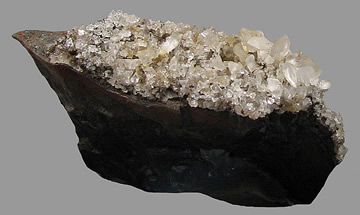
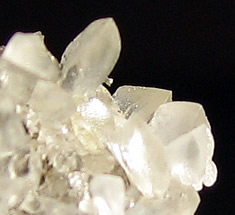
click on image
for larger view
SALAM9-1 Sal Ammoniac $22 SOLD
Sainte Fontaine Coal Mine, Moselle, Lorraine, France
3.9 cm x 1.2 cm x 3.2 cm; largest crystal = 4mm
Sal Ammoniac (NH4Cl) is a by-product of burning coal seams (and bat guano deposits!), so this mineral specimen probably formed from post-mining activities. Crystals are typically curved or distorted and have a plastic appearance. This coal mine was closed in 1987. Sal Ammoniac is water-soluble, so don't wash this specimen.
![]()
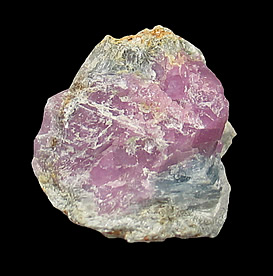
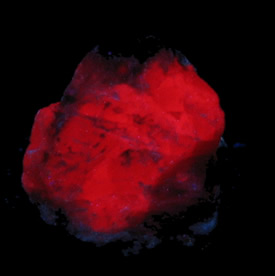
ordinary light
click
on image for larger view LWUV
SIM8-1 Sapphire in Margarite $22 SOLD
Statesville,
Iredell Co., North Carolina
2.6 x 2.8 x 2 cm
![]()
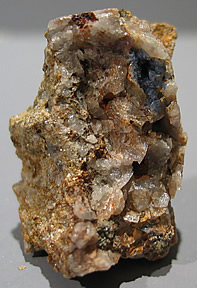
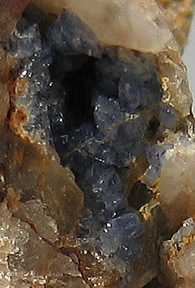
click on image
for larger view
SCO6-3 Scorodite $32 SOLD
Hemerdon Ball Mine, Plympton, Tavistock District, Devon, England
2.5 cm x 3.6 cm x 2.6 cm
A reference specimen of Scorodite Fe3+AsO4·2H2O crystals to 1 mm in a small vug. The Scorodite color didn't come out quite right; the crystals should be more greenish-blue.
![]()
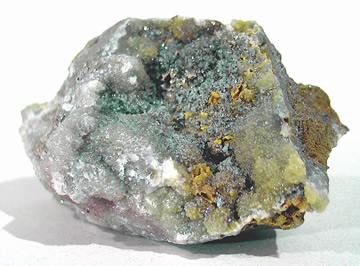
click on images
for larger views
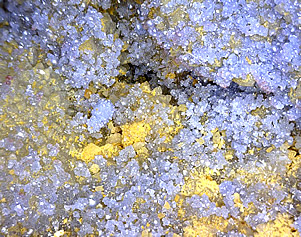
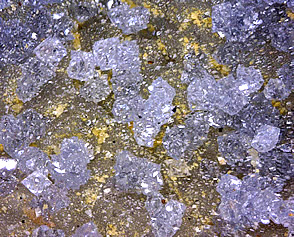 image on left
is 3 x 2.2 mm
image on right is 4 x 2.5 mm
image on left
is 3 x 2.2 mm
image on right is 4 x 2.5 mm
SCOR9-1 Scorodite and Barite $38 SOLD
El
Guanaco Mine, Guanaco, Santa Catalina, Antofagasta Province, Antofagasta
Region, Chile
6.0 cm x 4.1 cm x 3.8 cm; largest Scorodites ~ 0.5 mm
This Scorodite (Fe3+AsO4·2H2O) is one of the most dramatically color-changing minerals I have ever owned. The top photo is taken in a sun-spectrum Ott lamp. The camera had some trouble reproducing it, but the Scorodite is a pale grayish-blue green. When illuminated with LEDs (as in my Dino-Lite digital microscope), it turns bright lavender, as in the bottom photos.
![]()
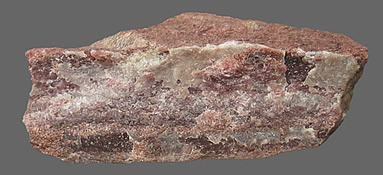

click on image
for larger view
SEP8-1
Sepiolite $15 SOLD
Little Cottonwood District, Wasatch Mts, Salt Lake Co., Utah
8.5 cm x 2.9 cm x 2.8 cm
This specimen is a bit puzzling. It comes with a Kristalle label identifying it as Parasepiolite, which is another name for Sepiolite (Mg4Si6O15(OH)2•6H2O). Sepiolite is supposed to be white, light gray or light yellow with a dull, earthy luster and hardness of 2, which means it can be scratched with a fingernail. There is only a very small patch of material soft enough to qualify as Sepiolite on this rock, but Sepiolite is indeed found in the Little Cottonwood District, so it might well be correct. You take your chances with this one, as I cannot guarantee the identification, hence the low price.
![]()
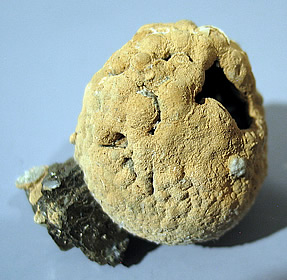
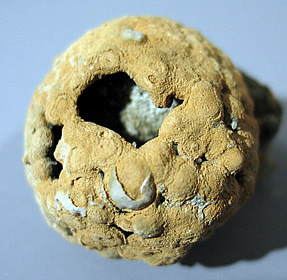
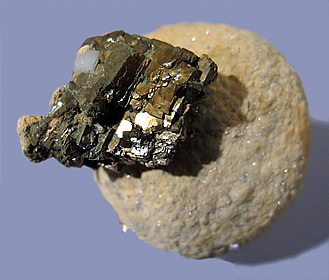
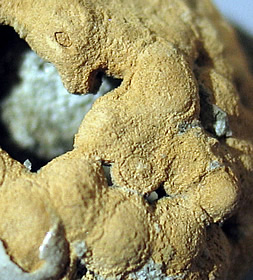
click on images
for larger views
GEO10-13 Chalcopyrite on Siderite nodule $65 SOLD
Nikolaevskiy
Mine, Dal'negorsk, Primorskiy
Kray,
Far-Eastern Region, Russia
4.9 cm x 3.8 cm x 3.5 cm
This bizarre Siderite (FeCO3) nodule is in the form of an open, hollow ball (see upper right photo), but the shell of the ball is itself made of smaller Siderite balls (see lower right photo). To make it even more odd, there is a beautiful compound Chalcopyrite (CuFeS2) crystal attached. These strange Siderites were found about 2 years ago. It seems likely that they formed around another type of nodular structure that subsequently dissolved.
![]()
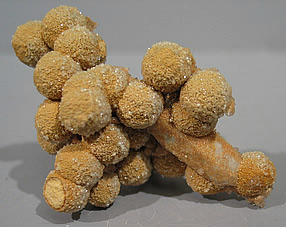
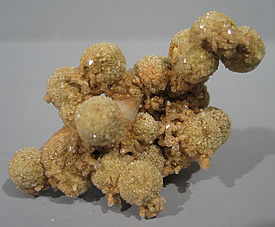
click on image
for larger view
SID8-1
Siderite Balls on Quartz $195 SOLD
2nd Sovietskiy Mine, Dal'negorsk, Primorskiy Kray, Russia
5.9 cm x 4.5 cm x 3.6 cm
A doubly-terminated Quartz is nestled inside a conglomeration of 1-cm-round, sparkly Siderite (FeCO3) balls. The DT Quartz is most visible in the left photo, its surface partially coated with Siderite. In the right photo, the tip of the quartz is just visible left of center. The tip has inclusions of Siderite. The sparkles are due to a sprinkling of small Quartz over the whole piece. The photo on the right shows that one side has more and larger Quartz/Siderite sprinkles than the other. This is the most aesthetic Siderite specimen that I have ever seen.
![]()

click on image for larger view
SIGL8-1
Sigloite (TL) $75 SOLD
Siglo Veinte Mine, Llallagua
Bustillos Province, Potosí Department, Bolivia
7.7 cm x 3.3 cm x 4 cm
Sigloite (Fe3+Al2[(OH)3|(PO4)2] • 7H2O) is an extremely rare mineral of the Paravauxite (Fe2+Al2[OH|PO4]2• 8H2O) group known from only 2 localities. This specimen is from the type locality and features crystals up to 5 mm in length on a carpet of microcrystalline Sigloite that covers nearly the whole display face. A very rich specimen of an exceedingly rare mineral.
![]()
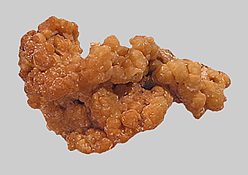
click on image
for larger view
TF5-49 Smithsonite
(variety Turkey Fat)
with Greenockite inclusions $28
The
pictured specimen is sold, but others
from $15 to $25 are available.
Monte Cristo Mine, Rush, Marion County, Arkansas
3 cm x 1.8 cm x 1.8 cm
The Smithsonite (ZnCO3) from the Monte Cristo Mine acquired a distinctive yellow color from the incorporation of cadmium Cd or the cadmium mineral, Greenockite (CdS). Most of this material was in the form of pseudomorphs of Dolomite, but this particular specimen is one of the few that retained its Smithsonite form, making it a bit of a rarity. The botryoidal shape of the Smithsonite plus the yellow color resembled turkey fat, hence the colorful varietal name. A good thumbnail of an American classic.
![]()
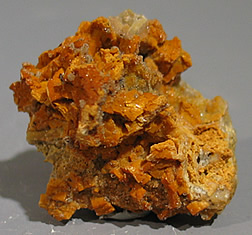
click on image
for larger view
TF9-1 Smithsonite (variety Turkey Fat) pseudomorph of Dolomite with Greenockite inclusions $60 SOLD
Monte
Cristo Mine, Rush, Marion County, Arkansas
3.5 cm x 3.2 cm x 2.5 cm
In this specimen, Smithsonite (ZnCO3) has replaced or covered Dolomite (CaMg(CO3)2) but has managed to preserve extremely sharp crystals. The pseudomorph has bright orangey-brown color due to Greenockite (CdS) inclusions, and sports a sparkling druze of tiny Quartz crystals on part of the specimen.
![]()
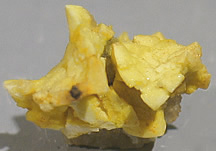
click
on image for larger view
TF5-34 Smithsonite (variety Turkey Fat) pseudomorph of Dolomite with Greenockite inclusions $28 SOLD
Monte
Cristo Mine, Rush, Marion County, Arkansas
2.0 cm x 2.0 cm x 1.3 cm
This pseudomorph is pale yellow Cadmium-containing Smithsonite replacing Dolomite, and it has faithfully preserved the curved crystal shape of the Dolomite.
![]()
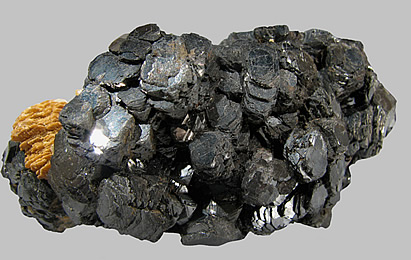
click on image
for larger view
MARM8-1
Sphalerite var. Marmatite $65 SOLD
Dal'negorsk, Primorskiy Kray, Far-Eastern Region, Russia
9.5 cm x 4.5 cm x 4 cm
Marmatite is a black variety of Sphalerite ((Zn, Fe2+)S), that is here represented by flat-topped crystals. Interspersed with those are the more traditional Sphalerites with triangular faces, which makes this a unique piece, presenting multiple habits in one specimen.
![]()
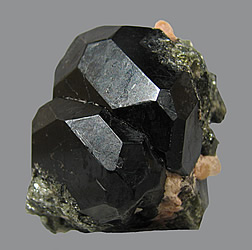
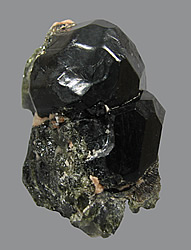
click on image
for larger view
GAHN8-1
Spinel on Diopside $95 SOLD
Aldan Shield, Saha Republic, Eastern-Siberian Region, Russia
5 cm x 3.5 cm x 3 cm
The latest find of these Spinels (MgAl2O4) was covered in the Jan-Feb 2008 Mineralogical Record, under the Munich Show Report (see page 66), but since I’ve had this one for years, I suspect it comes from the earlier find about 20 years ago. In any case, this locality has certainly established itself as remarkable for the size, quality and unusually elongated habit of the Spinels found there.
![]()
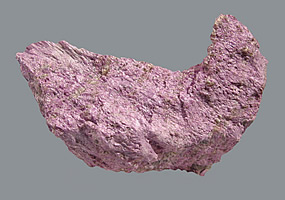
click on image
for larger view
STCH6-1
Stichtite $48 SOLD
Kaapsche Hoop, Barberton District
Mpumalanga Province, South Africa
5.5 cm x 4 cm x 1.8 cm
Imagine my surprise when I look up Stichtite (Mg6Cr2[(OH)16|CO3] · 4H2O) in www.mindat.org, and find that the photo they have chosen for the data page is currently this very piece! So if you are looking for a characteristic Stichtite, this lilac-pink chunk of pure fibrous Stichtite certainly qualifies. It's a member of the Hydrotalcite group and a much prettier than average rare mineral.
![]()
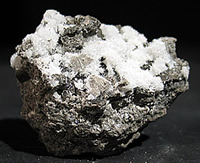
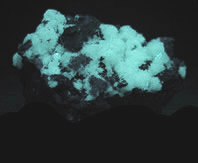
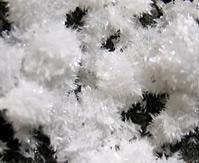
ordinary light
click
on image for larger view
SWUV
STRON9-1 Strontianite $15
The
pictured specimen is sold, but others are available.
Faylor-Middle Creek Quarry, Winfield, Union Co., Pennsylvania
5 x 3.5 x 3.8 cm
Balls of spiky white Strontianite (SrCO3) on limestone fluoresce and phosphoresce cream-blue under SWUV.
![]()
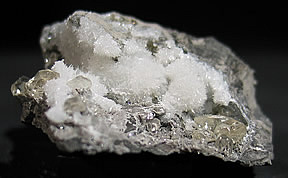
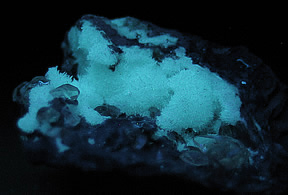
ordinary light
click
on image for larger view
SWUV
STRON9-3
Strontianite $18
The
pictured specimen is sold, but others are available.
Faylor-Middle Creek Quarry, Winfield, Union Co., Pennsylvania
4.8 x 2.2 x 7 cm
Well-separated balls of spiky white Strontianite (SrCO3) on limestone fluoresce and phosphoresce cream-blue under SWUV, set off by a few clear water-clear Calcites.
![]()
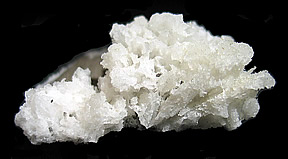
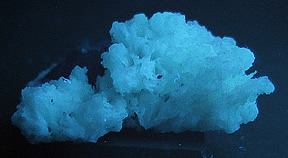
ordinary light
click
on image for larger view
SWUV
STRON9-4
Strontianite $20
The
pictured specimen is sold, but others are available.
Winfield, Union Co., Pennsylvania
4.4 x 2 x 3.2 cm
This looks like a pseudomorph or cast of Strontianite (SrCO3) after Calcite. It fluoresces and phosphoresces cream-blue under SWUV.
![]()
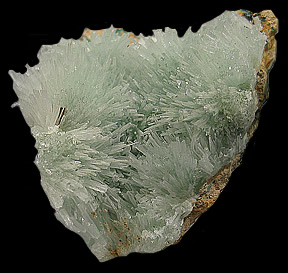
click on image
for larger view
STRN9-1 Green Strontianite $75 SOLD
Nandan County,
Hechi Prefecture,
Guangxi Zhuang Autonomous Region, China
5.8 cm x 4.6 cm x 3 cm
The result of a single small find in 2003, this pretty green Strontianite (SrCO3) presents a bit of a mystery. None of the main references on Chinese minerals mentions any location producing specimen-grade Strontianite, yet two-thirds of the world's strontium supply came from China in 2007! Definitely a rarity, yet pretty enough for display.
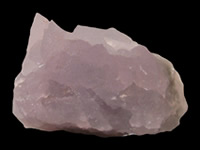
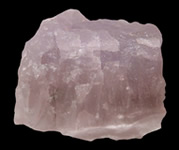
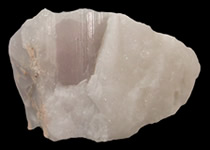
click on image for larger view
SUO8-1
Suolunite $150 SOLD
Mine Lac d'Amiante, Black Lake, Mégantic Co., Québec,
Canada
3.5 cm x 3 cm x 2 cm
Suolunite (Ca2[H2Si2O7] • H2O) is a rare mineral known from only 5 localities worldwide, and the Québec locality seems to have produced the best ones. This chunk of lilac-colored mineral displays V-shaped crystal aggregates on the side (middle photo), intergrown terminations on top (left photo), and curious striations on the bottom (right-hand photo) where the white matrix has been removed.
![]()
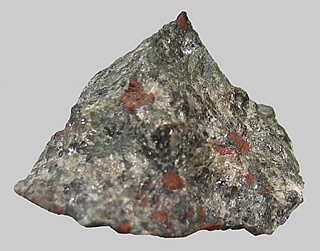
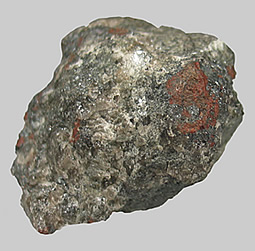
click on image
for larger view
DOV8-1
Synchysite-Y variety Doverite (TL) $65 SOLD
Scrub Oak Mine (Replogle Mine/Alan Wood Steel Co. Mine)
Mine Hill Borough, Morris Co., New Jersey
4.8 cm x 4 cm x 3 cm
The
Scrub Oak Mine was owned by Alan Wood Steel Co. back in the 1950’s
when Doverite (Ca(Y,Ce)[F|(CO3)2]) was described
as a new species using samples obtained at the mine. The US Atomic
Energy Commission sponsored the investigations because deposits of yttrium
(-Y) and other rare earths are often accompanied by radioactive thorium
and uranium. Indeed, most Doverite specimens are slightly radioactive.
This specimen likely dates to that period because it comes with
an anonymous label describing the mineral as Doverite from the Alan
Wood Steel Co. mine at Mine Hill. The similarity to Synchysite
was noted, and eventually Doverite became known as the –Y variety
of Synchysite. In this mineral specimen, the brick-red patches
are composed of Synchysite-Y. Here is a link to the paper describing
the chemistry of Doverite:
http://www.minsocam.org/ammin/AM45/AM45_92.pdf
![]()
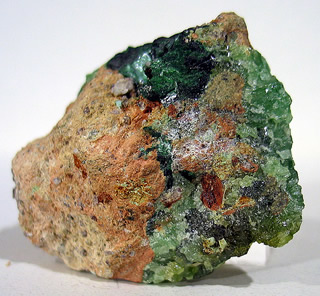
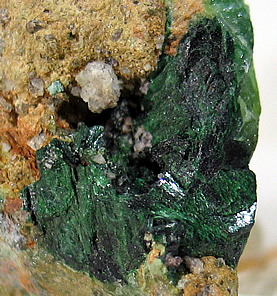
click
on any image for a larger view
image on right is 2.4 x 2.5 mm
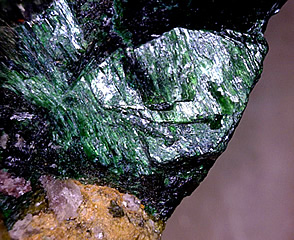
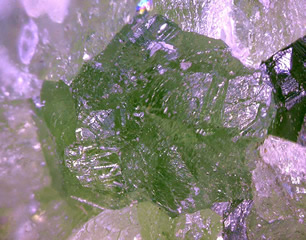
image on left
is 10 x 8 mm
image on right is 5 x 4 mm
SZ9-1
Szenicsite (TL) and Cuprian Powellite $95 SOLD
Jardinera No. 1 Mine, Inca de Oro, Chañaral Province,
Atacama Region, Chile
5.1 cm x 4.2 cm x 2.2 cm
Fibrous dark-green Szenicsite (Cu3(MoO4)(OH)4) paired with light-green, Cuprian Powellite (Ca[MoO4]). Szenicsite is an extremely rare mineral, found only one time and only in one location of about 1 cubic meter. Nearly all specimens have disappeared into collections. This sample has the additional distinction of being a good association piece. Surprisingly, even with the copper content, the Powellite still fluoresces bright cream-yellow under SWUV.
![]()
Galleries
of Sold Specimens:
A
B C D E F G H I
J K L M N O P Q R S T
U V W
XY
Z
Agates Sold Calcites Sold Mont St-Hilaire Sold
![]()
Questions? Please send me an email.
Home | Mineral Galleries | Index of Minerals | Contact | Links | Orders
© 2008 - 2009 Middle Earth Minerals
